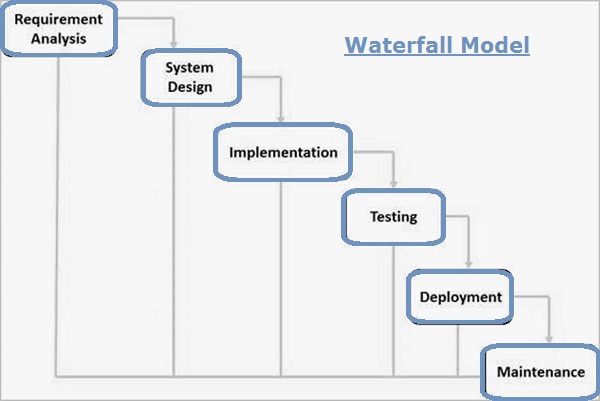In this tutorial you will learn about the Waterfall Model and its application with practical example.
Waterfall Model
The waterfall model is a prominent method to the software development life cycle (SDLC) in software engineering and product development. It is a linear, sequential approach to the SDLC. The waterfall paradigm stresses a step-by-step development. Distinct endpoints or goals are specified for each step of development and cannot be revisited after completion, similar to how water flows over the brink of a cliff. Dr. Winston W. Royce gave the phrase in a study published in 1970, and it is used in industrial design applications till today.
Phases In SDLC Waterfall Model
The waterfall approach is divided into seven distinct stages:
- Needs: Potential project requirements, timeframes, and guidelines are examined and incorporated into a functional specification. This stage deals with project definition and planning without naming particular methods.
- Analysis: The system specifications are examined in order to develop product models and business logic that will be used to guide production. This is also the point at which financial and technical resources are evaluated for viability.
- Design specifications are documents that specify technical design requirements such as programming language, hardware, data sources, architecture, and services.
- Coding/Implementation: The source code is created utilizing the models, logic, and requirements specified in the preceding steps. The system is often planned in smaller components, or units, before being executed as a whole.
- Testing: This is when quality assurance, unit, system, and beta tests are performed a location to report problems that need to be fixed this may necessitate a forced repetition of the coding step for debugging purposes. The waterfall continues if the system passes the tests. The code is extensively scrutinized and updated throughout testing. Small modules are initially evaluated in isolation. Following that, these modules are tested by adding some extra code to verify their interaction and the flow of intermediate output.
- Operation/Deployment: The product or application has been determined to be fully functioning and is ready for deployment in a live environment.
- Maintenance is performed endlessly to improve, update, and enhance the final product through corrective, adaptive, and perfective maintenance. This might involve the release of patch updates or the release of new versions.
Before proceeding to the next phase, there is normally a review and approval procedure to confirm that all set goals have been reached. Let’s have look at below graphical representation of the waterfall model;

When to use SDLC Waterfall Model?
The waterfall method is best suited for projects with detailed documentation, specified needs, enough resources, a well-defined timetable, and well-understood technology. Joint application development (JAD), rapid application development (RAD), sync-and-stabilize, agile project management (APM), and the spiral model are alternatives to the waterfall methodology.
Benefits of the SDLC Waterfall Model
While agile or dynamic approaches frequently replace the waterfall paradigm, they have the following advantages:
- Early documentation and planning phases enable big or moving teams to stay informed and work toward a single goal.
- Forces is a well-structured and disciplined organization.
- Is easy to grasp, follow, and organize chores.
- Allows for departmentalization and administrative control based on a timetable or deadline.
- It reinforces excellent coding habits such as defining before designing and then coding.
- Allows for easy early design or specification adjustments.
- Milestones and deadlines are clearly defined.

